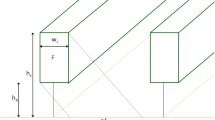Abstract
Based on radiative transfer theory in vegetation and geometric-optical principles, an analytical physical model for calculating multiangular, multispectral reflectance over a non-random, multiple component vegetation canopy is developed. This model is derived by taking advantages of the previous leaf canopy and multicomponent canopy BRF models. It quantitatively accounts for both the impact of foliage elements’ orientation on the canopy hotspot through an innovative algorithm to estimate the hotspot function for any arbitrarily oriented foliage element and contributions of all foliage elements to the reflectance by multiple scattering. Thus, it is characterized by more completely considering the integrative influence of spatial variations in optical and structural properties of all foliage elements on canopy reflectance than any previous analytical BRF models. Simulation results from this model demonstrate that canopy hotspot becomes strongest when the mean inclination angle of foliage elements is around 20°, and then it rapidly decreases with an increase in that angle. Comparison with field measured BRF data shows that this model can reproduce the angular asymmetrical distribution of canopy BRF, a feature of natural vegetation’s reflectance which all leaf canopy models cannot reproduce.
Similar content being viewed by others
References
Barnsley, M. J., Strahler, A.H., Morris, K.P.et al., Sampling of the surface bidirectional reflectance distribution function (BRDF): 1. Evaluation of current and future satellite sensors,Remote Sensing Reviews, 1994, 8:271.
Goel, N. S., Models of vegetation canopy reflectance and their use in estimation of biophysical parameters from reflectance data,Remote Sensing Reviews, 1988, 4:1.
Qin Wenhan, A review on studies of bidirectional reflectance of vegetation canopies,Remote Sens. Environ. China (in Chinese), 1992, 7:290.
Nilson, T., Kuusk, A., A reflectance model for the homogeneous plant canopy and its inversion,Remote Sens. Environ., 1989, 27:157.
Marshak, A. L., The effect of the hot spot on the transport equation in plant canopies,J. Quant. Spectrosc. Radiat. Transfer, 1989, 42:509.
Verstraete, M. M., Pinty, B., Dickinson, R. E., A physical model of the bidirectional reflectance of vegetation canopies: I. Theory,J. Geophys. Res., 1990, 95:11755.
Jupp, D.L. B., Strahler, A. H., A hotspot model for leaf canopies,Remote Sens. Environ., 1991, 38:193.
Qin Wenhan, Xiang Yueqin, On the hotspot effect of leaf canopies: Modeling study and influence of leaf shape,Remote Sens. Environ., 1994, 50:95.
Myneni, R.B., Asrar, G., Gerstl, S. A. W., Radiative transfer in three dimensional leaf canopies,Trans. Theory Stat. Phys., 1990, 19:205.
Qin Wenhan, Modeling the bidirectional reflectance of multicomponent vegetation canopies,Remote Sens. Environ., 1993, 46:235.
Qin Wenhan, Jupp, D. L. B., An analytical and computationally efficient reflectance model for leaf canopies,Agric. Forest Meteorol., 1993, 66:31.
Qin Wenhan, Goel, N.S., An evaluation of hotspot models for vegetation canopies,Remote Sensing Reviews, 1995, 13:121.
Nilson, T.,Photon-vegetation Interactions: Applications in Optical Remote Sensing and Plant Physiology (eds. Myneni, R. B., Ross, J.), New York: Springer-Verlag, 1991, 162–189.
Zhang Renhua, Qin Wenhan,Collection of Bidirectional Reflectance Spectrum of Main Crops in North China (in Chinese), Beijing: Science Press, 1991.
Ross, J.,The Radiation Regime and Architecture of Plant Stands, Hague-Boston-London: Dr.W. Junk Publishers, 1981, 90–116.
Author information
Authors and Affiliations
Additional information
Project supported by the National Natural Science Foundation of China and the President Fund of the Chinese Academy of Sciences.
Rights and permissions
About this article
Cite this article
Qin, W., Xiang, Y. An analytical model for bidirectional reflectance factor of multicomponent vegetation canopies. Sci. China Ser. C.-Life Sci. 40, 305–315 (1997). https://doi.org/10.1007/BF02879092
Received:
Issue Date:
DOI: https://doi.org/10.1007/BF02879092



